Qualitative Evaluation Method: Public Policy Programs Analysis
VerifiedAdded on 2021/06/17
|5
|1116
|90
Report
AI Summary
This report provides an overview of qualitative evaluation methods, emphasizing their importance in understanding public policies and programs. It distinguishes qualitative from quantitative approaches, highlighting the former's focus on narrative and its ability to capture nuanced insights into participant experiences. The report details three key qualitative methods: in-depth interviews, the analysis of written documents, and direct observation. Each method is described with its appropriate applications, steps involved, and suitability for evaluating policies and programs. The report highlights the strengths of each approach, such as the ability of in-depth interviews to provide a human perspective, the cost-effectiveness of using written documents, and the holistic view gained through direct observation. It concludes by acknowledging the subjective nature of qualitative methods while underscoring their value in providing comprehensive and in-depth information within social contexts.
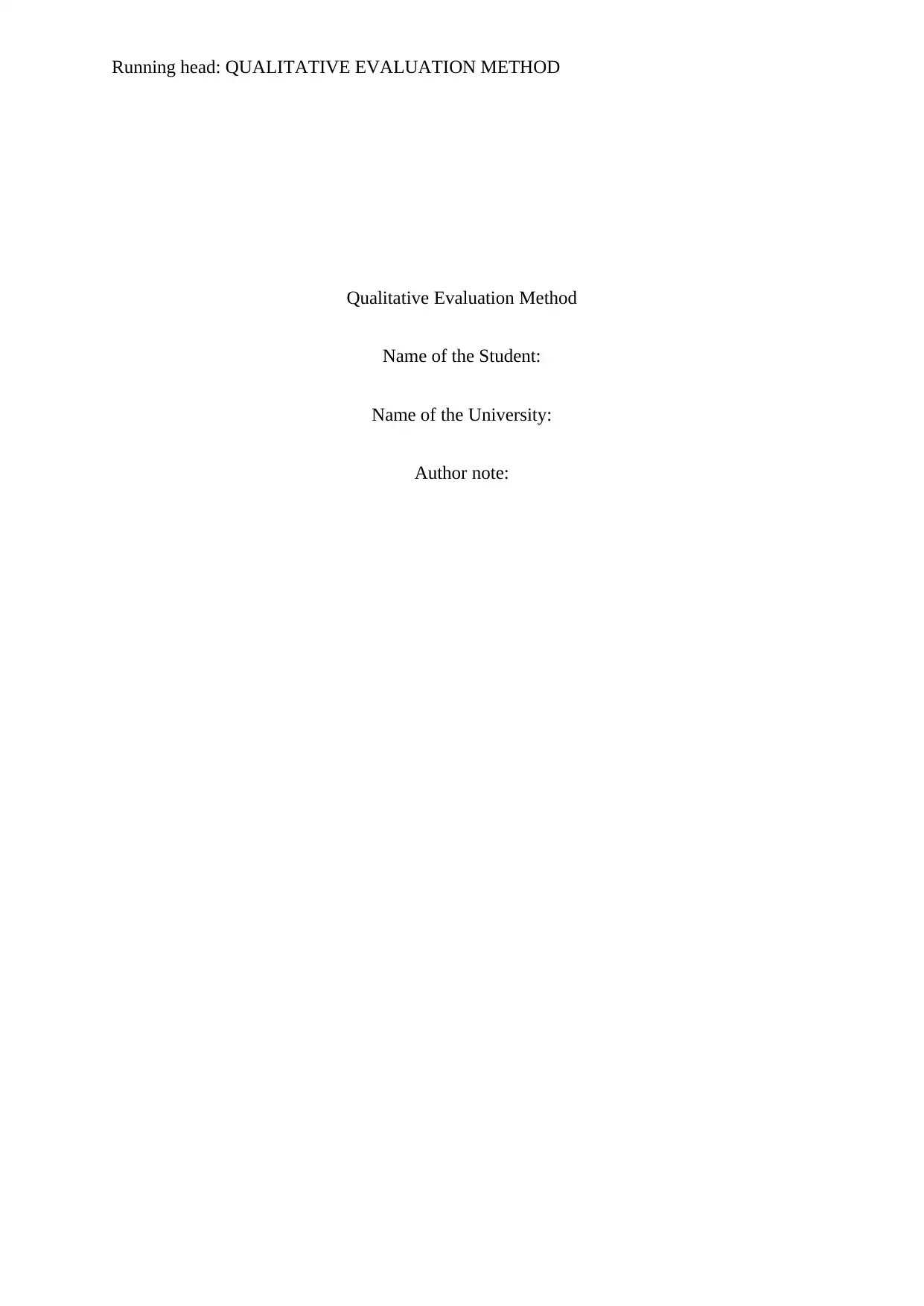
Running head: QUALITATIVE EVALUATION METHOD
Qualitative Evaluation Method
Name of the Student:
Name of the University:
Author note:
Qualitative Evaluation Method
Name of the Student:
Name of the University:
Author note:
Paraphrase This Document
Need a fresh take? Get an instant paraphrase of this document with our AI Paraphraser
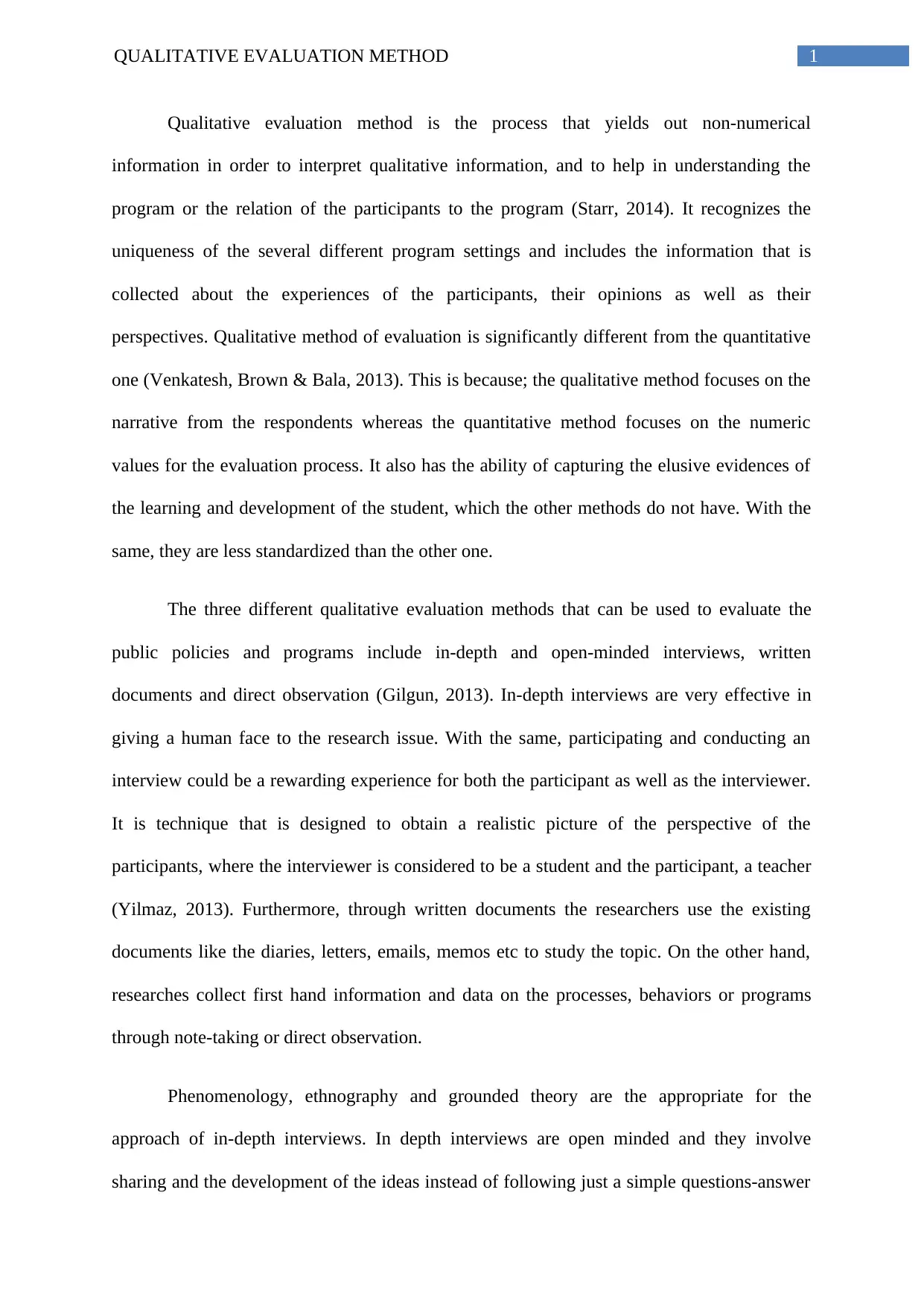
1QUALITATIVE EVALUATION METHOD
Qualitative evaluation method is the process that yields out non-numerical
information in order to interpret qualitative information, and to help in understanding the
program or the relation of the participants to the program (Starr, 2014). It recognizes the
uniqueness of the several different program settings and includes the information that is
collected about the experiences of the participants, their opinions as well as their
perspectives. Qualitative method of evaluation is significantly different from the quantitative
one (Venkatesh, Brown & Bala, 2013). This is because; the qualitative method focuses on the
narrative from the respondents whereas the quantitative method focuses on the numeric
values for the evaluation process. It also has the ability of capturing the elusive evidences of
the learning and development of the student, which the other methods do not have. With the
same, they are less standardized than the other one.
The three different qualitative evaluation methods that can be used to evaluate the
public policies and programs include in-depth and open-minded interviews, written
documents and direct observation (Gilgun, 2013). In-depth interviews are very effective in
giving a human face to the research issue. With the same, participating and conducting an
interview could be a rewarding experience for both the participant as well as the interviewer.
It is technique that is designed to obtain a realistic picture of the perspective of the
participants, where the interviewer is considered to be a student and the participant, a teacher
(Yilmaz, 2013). Furthermore, through written documents the researchers use the existing
documents like the diaries, letters, emails, memos etc to study the topic. On the other hand,
researches collect first hand information and data on the processes, behaviors or programs
through note-taking or direct observation.
Phenomenology, ethnography and grounded theory are the appropriate for the
approach of in-depth interviews. In depth interviews are open minded and they involve
sharing and the development of the ideas instead of following just a simple questions-answer
Qualitative evaluation method is the process that yields out non-numerical
information in order to interpret qualitative information, and to help in understanding the
program or the relation of the participants to the program (Starr, 2014). It recognizes the
uniqueness of the several different program settings and includes the information that is
collected about the experiences of the participants, their opinions as well as their
perspectives. Qualitative method of evaluation is significantly different from the quantitative
one (Venkatesh, Brown & Bala, 2013). This is because; the qualitative method focuses on the
narrative from the respondents whereas the quantitative method focuses on the numeric
values for the evaluation process. It also has the ability of capturing the elusive evidences of
the learning and development of the student, which the other methods do not have. With the
same, they are less standardized than the other one.
The three different qualitative evaluation methods that can be used to evaluate the
public policies and programs include in-depth and open-minded interviews, written
documents and direct observation (Gilgun, 2013). In-depth interviews are very effective in
giving a human face to the research issue. With the same, participating and conducting an
interview could be a rewarding experience for both the participant as well as the interviewer.
It is technique that is designed to obtain a realistic picture of the perspective of the
participants, where the interviewer is considered to be a student and the participant, a teacher
(Yilmaz, 2013). Furthermore, through written documents the researchers use the existing
documents like the diaries, letters, emails, memos etc to study the topic. On the other hand,
researches collect first hand information and data on the processes, behaviors or programs
through note-taking or direct observation.
Phenomenology, ethnography and grounded theory are the appropriate for the
approach of in-depth interviews. In depth interviews are open minded and they involve
sharing and the development of the ideas instead of following just a simple questions-answer
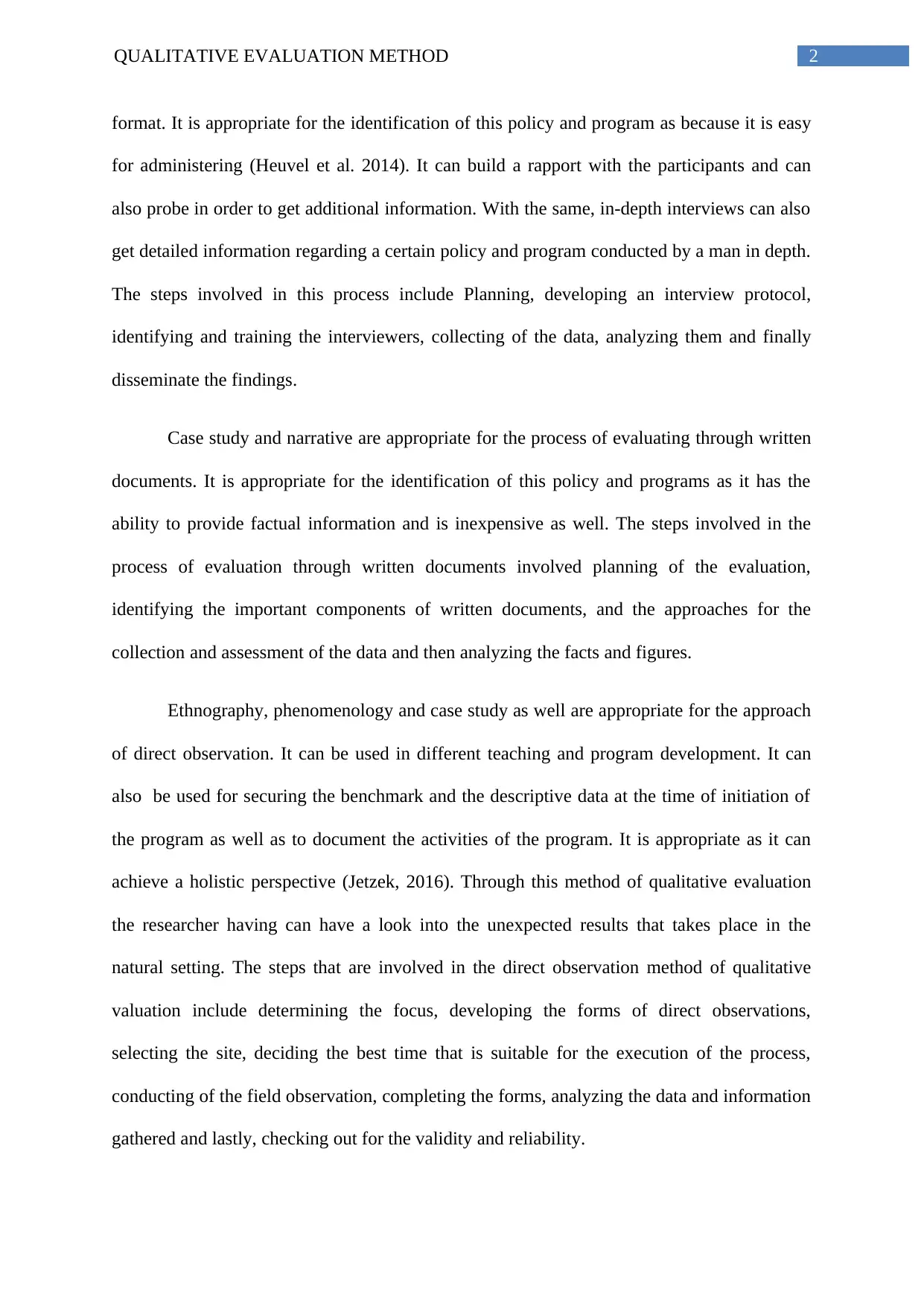
2QUALITATIVE EVALUATION METHOD
format. It is appropriate for the identification of this policy and program as because it is easy
for administering (Heuvel et al. 2014). It can build a rapport with the participants and can
also probe in order to get additional information. With the same, in-depth interviews can also
get detailed information regarding a certain policy and program conducted by a man in depth.
The steps involved in this process include Planning, developing an interview protocol,
identifying and training the interviewers, collecting of the data, analyzing them and finally
disseminate the findings.
Case study and narrative are appropriate for the process of evaluating through written
documents. It is appropriate for the identification of this policy and programs as it has the
ability to provide factual information and is inexpensive as well. The steps involved in the
process of evaluation through written documents involved planning of the evaluation,
identifying the important components of written documents, and the approaches for the
collection and assessment of the data and then analyzing the facts and figures.
Ethnography, phenomenology and case study as well are appropriate for the approach
of direct observation. It can be used in different teaching and program development. It can
also be used for securing the benchmark and the descriptive data at the time of initiation of
the program as well as to document the activities of the program. It is appropriate as it can
achieve a holistic perspective (Jetzek, 2016). Through this method of qualitative evaluation
the researcher having can have a look into the unexpected results that takes place in the
natural setting. The steps that are involved in the direct observation method of qualitative
valuation include determining the focus, developing the forms of direct observations,
selecting the site, deciding the best time that is suitable for the execution of the process,
conducting of the field observation, completing the forms, analyzing the data and information
gathered and lastly, checking out for the validity and reliability.
format. It is appropriate for the identification of this policy and program as because it is easy
for administering (Heuvel et al. 2014). It can build a rapport with the participants and can
also probe in order to get additional information. With the same, in-depth interviews can also
get detailed information regarding a certain policy and program conducted by a man in depth.
The steps involved in this process include Planning, developing an interview protocol,
identifying and training the interviewers, collecting of the data, analyzing them and finally
disseminate the findings.
Case study and narrative are appropriate for the process of evaluating through written
documents. It is appropriate for the identification of this policy and programs as it has the
ability to provide factual information and is inexpensive as well. The steps involved in the
process of evaluation through written documents involved planning of the evaluation,
identifying the important components of written documents, and the approaches for the
collection and assessment of the data and then analyzing the facts and figures.
Ethnography, phenomenology and case study as well are appropriate for the approach
of direct observation. It can be used in different teaching and program development. It can
also be used for securing the benchmark and the descriptive data at the time of initiation of
the program as well as to document the activities of the program. It is appropriate as it can
achieve a holistic perspective (Jetzek, 2016). Through this method of qualitative evaluation
the researcher having can have a look into the unexpected results that takes place in the
natural setting. The steps that are involved in the direct observation method of qualitative
valuation include determining the focus, developing the forms of direct observations,
selecting the site, deciding the best time that is suitable for the execution of the process,
conducting of the field observation, completing the forms, analyzing the data and information
gathered and lastly, checking out for the validity and reliability.
⊘ This is a preview!⊘
Do you want full access?
Subscribe today to unlock all pages.

Trusted by 1+ million students worldwide
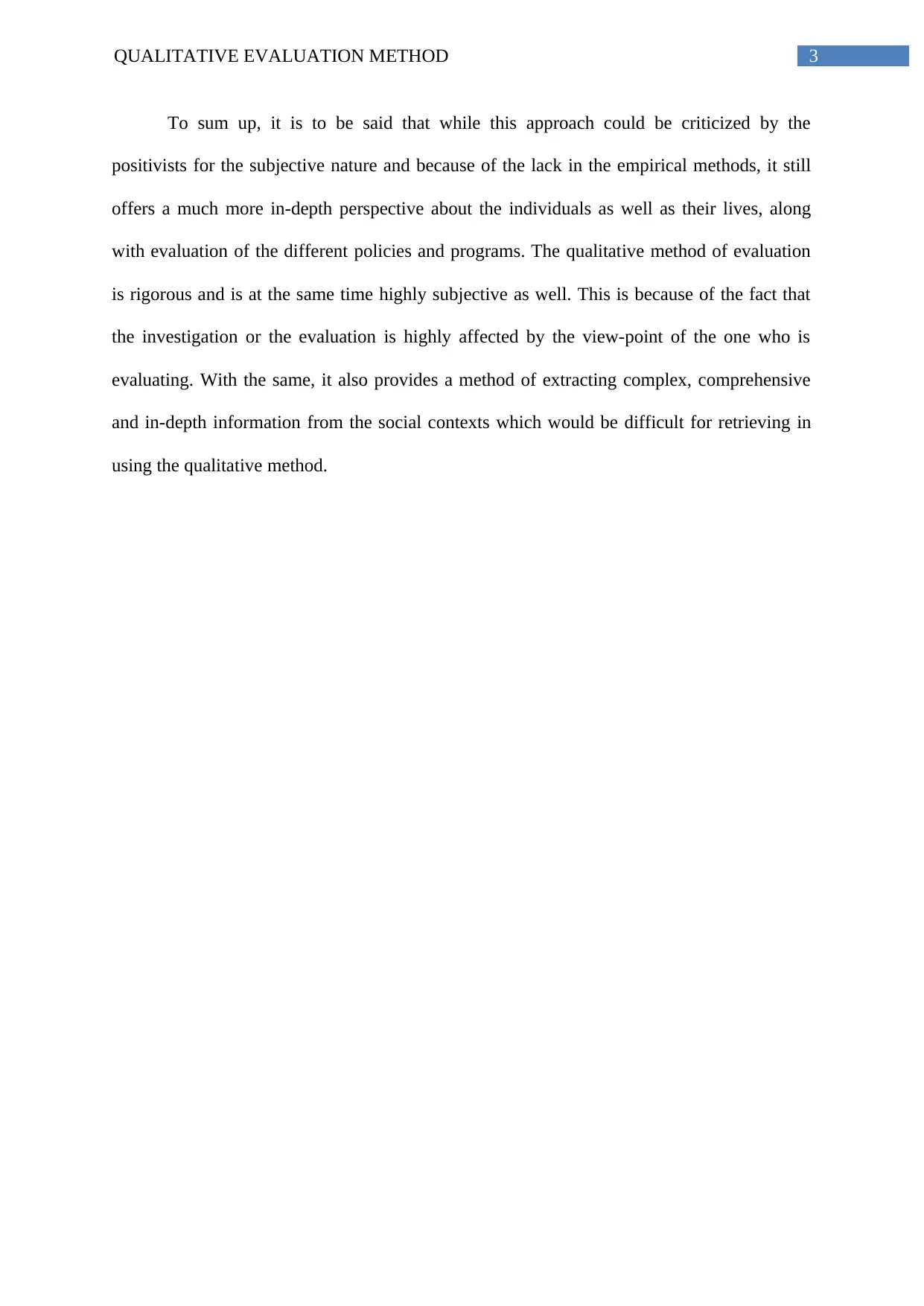
3QUALITATIVE EVALUATION METHOD
To sum up, it is to be said that while this approach could be criticized by the
positivists for the subjective nature and because of the lack in the empirical methods, it still
offers a much more in-depth perspective about the individuals as well as their lives, along
with evaluation of the different policies and programs. The qualitative method of evaluation
is rigorous and is at the same time highly subjective as well. This is because of the fact that
the investigation or the evaluation is highly affected by the view-point of the one who is
evaluating. With the same, it also provides a method of extracting complex, comprehensive
and in-depth information from the social contexts which would be difficult for retrieving in
using the qualitative method.
To sum up, it is to be said that while this approach could be criticized by the
positivists for the subjective nature and because of the lack in the empirical methods, it still
offers a much more in-depth perspective about the individuals as well as their lives, along
with evaluation of the different policies and programs. The qualitative method of evaluation
is rigorous and is at the same time highly subjective as well. This is because of the fact that
the investigation or the evaluation is highly affected by the view-point of the one who is
evaluating. With the same, it also provides a method of extracting complex, comprehensive
and in-depth information from the social contexts which would be difficult for retrieving in
using the qualitative method.
Paraphrase This Document
Need a fresh take? Get an instant paraphrase of this document with our AI Paraphraser
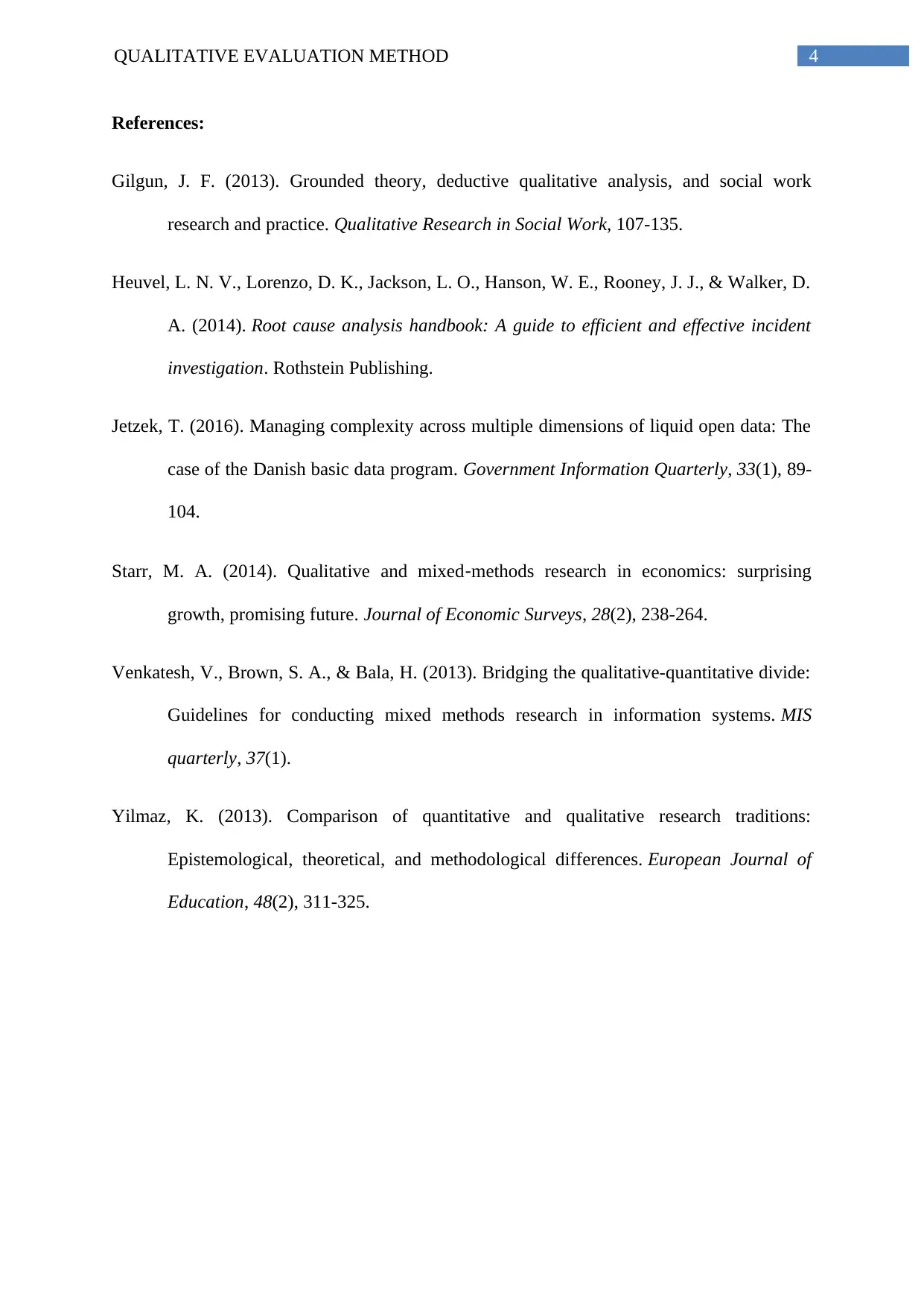
4QUALITATIVE EVALUATION METHOD
References:
Gilgun, J. F. (2013). Grounded theory, deductive qualitative analysis, and social work
research and practice. Qualitative Research in Social Work, 107-135.
Heuvel, L. N. V., Lorenzo, D. K., Jackson, L. O., Hanson, W. E., Rooney, J. J., & Walker, D.
A. (2014). Root cause analysis handbook: A guide to efficient and effective incident
investigation. Rothstein Publishing.
Jetzek, T. (2016). Managing complexity across multiple dimensions of liquid open data: The
case of the Danish basic data program. Government Information Quarterly, 33(1), 89-
104.
Starr, M. A. (2014). Qualitative and mixed‐methods research in economics: surprising
growth, promising future. Journal of Economic Surveys, 28(2), 238-264.
Venkatesh, V., Brown, S. A., & Bala, H. (2013). Bridging the qualitative-quantitative divide:
Guidelines for conducting mixed methods research in information systems. MIS
quarterly, 37(1).
Yilmaz, K. (2013). Comparison of quantitative and qualitative research traditions:
Epistemological, theoretical, and methodological differences. European Journal of
Education, 48(2), 311-325.
References:
Gilgun, J. F. (2013). Grounded theory, deductive qualitative analysis, and social work
research and practice. Qualitative Research in Social Work, 107-135.
Heuvel, L. N. V., Lorenzo, D. K., Jackson, L. O., Hanson, W. E., Rooney, J. J., & Walker, D.
A. (2014). Root cause analysis handbook: A guide to efficient and effective incident
investigation. Rothstein Publishing.
Jetzek, T. (2016). Managing complexity across multiple dimensions of liquid open data: The
case of the Danish basic data program. Government Information Quarterly, 33(1), 89-
104.
Starr, M. A. (2014). Qualitative and mixed‐methods research in economics: surprising
growth, promising future. Journal of Economic Surveys, 28(2), 238-264.
Venkatesh, V., Brown, S. A., & Bala, H. (2013). Bridging the qualitative-quantitative divide:
Guidelines for conducting mixed methods research in information systems. MIS
quarterly, 37(1).
Yilmaz, K. (2013). Comparison of quantitative and qualitative research traditions:
Epistemological, theoretical, and methodological differences. European Journal of
Education, 48(2), 311-325.
1 out of 5
Related Documents
Your All-in-One AI-Powered Toolkit for Academic Success.
+13062052269
info@desklib.com
Available 24*7 on WhatsApp / Email
![[object Object]](/_next/static/media/star-bottom.7253800d.svg)
Unlock your academic potential
Copyright © 2020–2025 A2Z Services. All Rights Reserved. Developed and managed by ZUCOL.





